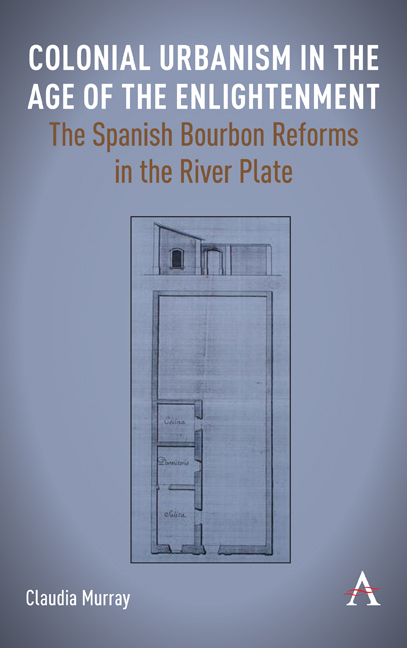Book contents
- Frontmatter
- Contents
- List of Figures and Tables
- Acknowledgements
- Introduction
- 1 The Spanish Empire Before the Bourbon Reforms
- 2 The River Plate Before 1776 and the Bourbon Reforms
- 3 Urban Expansion
- 4 The Image of Power
- 5 Ceremonies of Power
- 6 Disciplining Porteños’ Private Architecture
- 7 The British Assault on the River Plate
- Appendix 1
- Bibliography
- Index
3 - Urban Expansion
Published online by Cambridge University Press: 28 February 2024
- Frontmatter
- Contents
- List of Figures and Tables
- Acknowledgements
- Introduction
- 1 The Spanish Empire Before the Bourbon Reforms
- 2 The River Plate Before 1776 and the Bourbon Reforms
- 3 Urban Expansion
- 4 The Image of Power
- 5 Ceremonies of Power
- 6 Disciplining Porteños’ Private Architecture
- 7 The British Assault on the River Plate
- Appendix 1
- Bibliography
- Index
Summary
Land Control Changes
Colonial Spanish cities had three well-defined areas that radiated from the centre where the main square or plaza mayor was located, extending from here to the periphery and the surrounding fields. The first inner area was the urban core and where public buildings were located and where the original settlers had their dwellings. This core was usually divided into square blocks of 140 varas side (approximately 120 metres). Surrounding this, was the ejido, which was land shared by the community and administered by the town council, all settlers with a house in the core had a right to use these com¬mons for grazing the farmstock that they had in the town (most families had a couple of livestock for daily milk and eggs consumption). Beyond the ejido was the land divided into agricultural plots – called suertes (luck). The suertes were randomly allocated to the first settlers and used for agriculture. Beyond this area, the lands belonged to the Spanish Crown and were known as tierras realengas.
In order to ensure that the settlers remained in the colony, the Crown required that a minimum of five years residency cultivating the land and maintaining a dwelling in the core, earning full possession of the property after this period. However, some settlers migrated to other more hospitable areas of the empire, leaving behind empty plots in the city along with uncultivated suertes. The problem was that by the sixteenth century, there was a surge in empty urban plots, and it became difficult to monitor which owners were forfeiting their rights to the land or if they intended to return. The Crown therefore resolved that those who had reasons to leave a settlement but did not intend to emigrate had to appoint a ‘fully armed’ person in their place in case of enemy attack. This problem of settlers abandoning colonies was common particularly during the sixteenth century, when Spain was expanding its dominions and settlements. This prompted the Crown to order that settlers build houses as soon as possible, preferably in stone. Presumably intending that a capital investment would tie people to the land.
- Type
- Chapter
- Information
- Colonial Urbanism in the Age of the EnlightenmentThe Spanish Bourbon Reforms in the River Plate, pp. 53 - 78Publisher: Anthem PressPrint publication year: 2023



